 Calm is approachable.
Calm is approachable.
So, if you want to become more approachable to others, start by being calmer yourself.
See, when you’re at ease with yourself, other people will feel the same. And as a result, they will feel more comfortable in your presence, which will make them more comfortable opening up.
THINK ABOUT IT: Do you really want to approach (or be approached by) someone who is overly stressed, constantly worried, jerky or pacing back and forth?
Doubtful.
IN FACT, THINK ABOUT THIS: Who’s the calmest, most relaxed and peaceful person you know?
That person’s probably pretty approachable, huh?
SO, THE SECRET IS: To put others at ease, start with yourself.
Your challenge is to incorporate calmness into various aspects of your daily life; then allow it to transfer to the people you encounter. Here’s a list of six practices to help you do so:
1. Daily Appointments with Yourself. Take 30-60 minutes every morning to do nothing other than think, relax and just BE. Focus on your breathing, read positive materials, practice affirmations and listen to great music.
This will prime your brain to face the day with calmness and peace. For a step-by-step guide on how to have a Daily Appointment, read this.
2. Incorporate breathing into EVERYTHING. My friend Robert Friedman, an expert on stress solutions, teaches people to incorporate mindful breathing into every aspect of their lives. He suggests being more mindful of your breathing during mundane activities like reading, writing, opening doors and before answering the phone.
“By increasing oxygen level and Alpha Wave flow to your brain,” Robert says, “You relax your mind, body and spirit,” he explains.
3. Affirmation. If you feel hurried, impatient or fidgety during the day, take a minute or two to affirm to yourself, “There are no emergencies,” or “I am enough, I do enough, I have enough.” This will build a foundation of calmness throughout your soul that can’t help but be contagious to the people you interact with.
And if you think affirmations are cheesy, you’re right. They are. But that doesn’t mean they don’t work 😉
4. Meditation. Don’t be intimidated by this word. You don’t have to be a Yogi Master or a Tibetan Monk to practice meditation. In fact, the word is defined as, “continued or extended thought or reflection.” And it comes from the Latin word “to contemplate.”
So, find periods in your day where you can be silent, mindful and reflective … by yourself. Anywhere from five to twenty minutes should be enough to calm you down.
5. Silence. Because of our “always on,” hyperspeed, information overload culture, silence is difficult for a lot of people. However, what you’ll discover is that silence is an important tool for projecting approachability. Here’s how it works:
o The more you practice silence alone, the more comfortable you will be during silence with others.
o The more comfortable silence is with others, the safer the atmosphere becomes.
o The safer the atmosphere becomes, the more likely you are to share your authentic feelings, concerns and questions.
How much silent time have YOU taken today?
6. Exercise. First of all, if you’re not already exercising every single day, you’re NUTS! More specifically, people who do so every day are calmer because they have an outlet to release their tensions, stresses and anxieties.
Even if it means walking for 15 minutes a day, do it! It’s not only essential for your health; it’s also a contributor to your calmness throughout the rest of the day.
REMEMBER: Calm is approachable.
So, if you want to put customers, coworkers and employees at ease, start with yourself!
LET ME ASK YA THIS…
How do you put yourself at ease?
LET ME SUGGEST THIS…
Share your techniques and best practices here!
* * * *
Scott Ginsberg
That Guy with the Nametag
[email protected]
 Going on a sales call today?
Going on a sales call today?
Tune in to The Sales Channel on NametagTV.com!
Watch video lessons on selling enabling customers to buy!

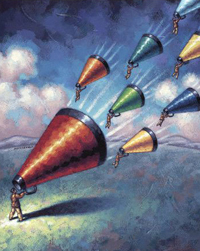 Rehearsal.
Rehearsal.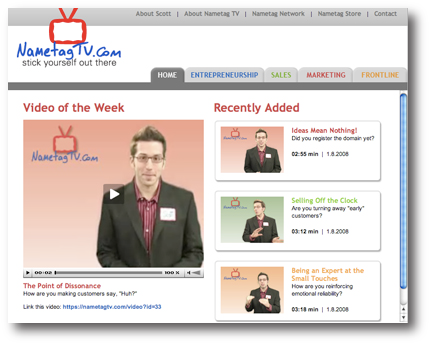
 Let’s talk about “tolerance.”
Let’s talk about “tolerance.” Enjoy this post?
Enjoy this post? Yes, it IS possible to be TOO approachable.
Yes, it IS possible to be TOO approachable. Enjoy this post?
Enjoy this post? I’ve been reading Joe Meyers’ new book,
I’ve been reading Joe Meyers’ new book,  Enjoy this post?
Enjoy this post? Call it optimism.
Call it optimism.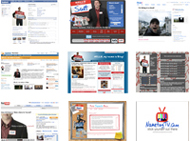 Are you a friend of
Are you a friend of  Yes, all that positive attitude stuff is TOTALLY corny.
Yes, all that positive attitude stuff is TOTALLY corny. Are you a friend of
Are you a friend of 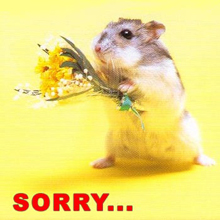 People say sorry WAY too often.
People say sorry WAY too often.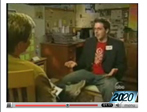 Are you the luckiest person you know?
Are you the luckiest person you know?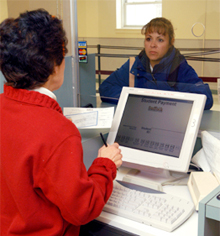 I pushed my shopping cart up to the counter.
I pushed my shopping cart up to the counter. * * * *
* * * * Competition is all about attitude.
Competition is all about attitude. * * * *
* * * *